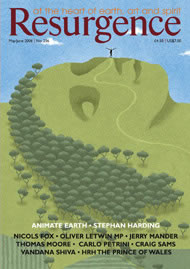IN 2003, THAMES & HUDSON published a world history of brick by James W. P. Campbell and the award-winning photographer Will Pryce, which I enthusiastically reviewed in Resurgence 227. A twin of this book has now been issued; this time the text and photographs are both by Pryce. It looks as if he has travelled round the world in the proverbial eighty days photographing every wooden building of significance.
The author emphasises the importance of wood as a building material and that it was at one time virtually ubiquitous. Today, of course, what is left is but a fraction of what was built in the past. As recently as the beginning of the 19th century wood was still the most popular building material in most of Central, Eastern and Northern Europe, North America, South-East Asia and Japan. Cities such as Strasbourg, Rouen and New York contained as many wooden buildings as masonry ones, and Moscow, Tokyo, Bangkok and Beijing contained a higher proportion.
In the UK oak proved the most popular building material. Close-grained and very strong, it is the least likely to warp or crack even when used green, and the survival of original oak timbers in St Andrew’s Church in Greenstead, Essex, dating back 1,000 years, are a testimony of its outstanding durability. The survival of so many ancient wooden buildings in this country is a reflection of the extent to which the environment once provided this natural building material.
Nonetheless, as Pryce laments, in spite of the fact that many of the world’s finest buildings have been made of wood, it is a material that has been consistently undervalued or ignored in histories of architecture. Perhaps it’s true that there isn’t a single wooden building which can be compared with such monumental buildings as, say, the Parthenon in Athens, or Chartres Cathedral. All the same there are hundreds of wood-based buildings which merit serious consideration – the onion-domed Cathedral of the Transfiguration on Kizhi Island in Russia, or the Golden Pavilion in Kyoto, Japan, to take just two examples. There are also a considerable number of vernacular buildings that possess an inimitability, a charm and beauty no less wonderful and in a way perhaps more human than many stone and brick-built houses and churches. These include the medieval tithe barns of England, the stave churches of Norway, the five-storey pagodas and temples of Japan, and of course the countless small wooden buildings that formerly made up the pre-industrial towns, cities and villages of Europe and the Far East.
Yet as cities grew, the ever-present threat of fire became a hazard and one that was solved by the introduction of new materials. Iron, steel and concrete could also span greater distances than wood, thus enabling the construction of considerably larger buildings. This development of technically advanced materials found further support at the start of the 20th century with the standard-bearers of the European Modern movement in architecture. Ideologically wood was a reminder of a ‘backward’ vernacular, which had at all costs to be avoided. Walter Gropius, Ludwig Mies van der Rohe and Le Corbusier believed that concrete, glass and steel were more befitting the spirit of the new age of speed, health and efficiency.
With the decay of this ultimately sterile utopianism and its replacement by more ecological considerations, the quest for monumentality and permanence inherent in the old order is now being questioned. Sustainability is another factor, as is the importance of the comfort of the spirit. Pointers to this future can be seen in the architecture of the Hungarian Imre Makovecz, whose use of wood is paralleled by his inspired employment of organic forms. The book also reproduces photographs of buildings designed by Edward Cullinan and E. Fay Jones, whose work was a development of the ‘organic architecture’ of Frank Lloyd Wright.
Pryce points out that the seemingly permanent monuments of today – skyscrapers, airports and factories – are nothing of the sort. “The average skyscraper, for instance, will require a major overhaul or replacement after only thirty or forty years and steel frames will last at best 150 years whereas oak frames survive for over 800.” But if the sheer mass of these structures gives them the appearance of permanence, it is an illusion that comes at a tremendous cost to the environment. Pryce continues, “While wooden buildings can last for thousands of years, they are also entirely biological, non-toxic and ultimately biodegradable. In the face of growing environmental threats, building with wood may prove not only desirable but necessary.”
John Lane is a writer and painter. His most recent book is The Spirit of Silence.







